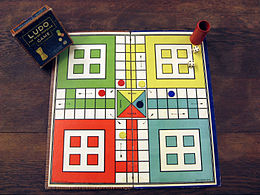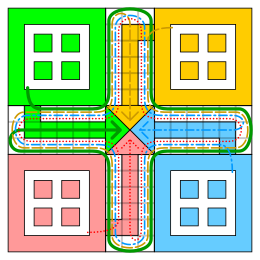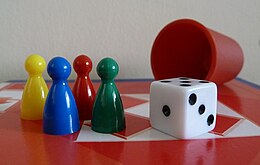ALL ABOUT LUDO: BOARD GAME
Ludo is a strategy board game for two to four players, in which the players race their four tokens from start to finish according to the rolls of a single die. Like other cross and circle games, Ludo is derived from the Indian game Pachisi, but simpler. The game and its variations are popular in many countries and under various names.
| Years active | Since c. 1896 |
|---|---|
| Genre(s) | Board game Race game Dice game |
| Players | 2–4 |
| Playing time | < 90 min |
| Random chance | High (dice rolling) |
| Skill(s) required | Strategy, tactics, counting, probability |
History
Pachisi was created in India in the 6th century. The earliest evidence of this game evolution in India is the depiction of boards on the caves of Ellora. The original version is also described in Mahabharata, where Draupadi was put on stake by Pandavas. It was also known as "Chopad". The contemporary version was played by the Mughal emperors of India; a notable example is Akbar.
Pachisi was modified to use a cubic die with dice cup and patented as "Ludo" in England in 1896.The Royal Navy took Ludo and converted it into the board game Uckers.
Ludo board
Special areas of the Ludo board are typically coloured bright yellow, green, red, and blue. Each player is assigned a colour and has four tokens in their colour. The board is normally square with a cross-shaped playspace, with each arm of the cross having three columns of squares, usually six per column. The middle columns usually have five squares coloured; these represent a player's home column. A sixth coloured square not on the home column is a player's starting square. At the centre of the board is a large finishing square, often composed of coloured triangles atop the players' home columns (thus depicting "arrows" pointing to the finish).

Rules
Overview
Two, three, or four can play, without partnerships.At the beginning of the game, each player's four tokens are out of play and staged in the player's yard (one of the large corner areas of the board in the player's colour). When able to, the players will enter their tokens one per turn on their respective starting squares, and proceed to race them clockwise around the board along the game track (the path of squares not part of any player's home column). When reaching the square below his home column, a player continues by moving tokens up the column to the finishing square. The rolls of a single die.control the swiftness of the tokens, and entry to the finishing square requires a precise roll from the player. The first to bring all their tokens to the finish wins the game. The others often continue play to determine second-, third-, and fourth-place finishers.
Gameplay
Each player rolls the die; the highest roller begins the game. Players alternate turns in a clockwise direction.
To enter a token into play from its yard to its starting square, a player must roll a 6.If the player has no tokens yet in play and rolls other than a 6, the turn passes to the next player. Once a player has one or more tokens in play, he selects a token and moves it forwards along the track the number of squares indicated by the die. Players must always move a token according to the die value rolled. Passes are not allowed; if no move is possible, the turn moves to the next player.
When a 6 is rolled, the player may choose to advance a token already in play, or may enter another staged token to its starting square. Rolling a 6 earns the player an additional or "bonus" roll in that turn. If the bonus roll results in a 6 again, the player earns an additional bonus roll.If the third roll is also a 6, the player may not move and the turn immediately passes to the next player.
Players may not end their move on a square they already occupy. If the advance of a token ends on a square occupied by an opponent's token, the opponent token is returned to its owner's yard. The returned token can be reentered into play only when the owner rolls a 6. Unlike Pachisi, there are no "safe" squares on the game track which protect a player's tokens from being returned. A player's home column squares are always safe, however, since no opponent may enter them.The player can end the game with a 6 only.

Nomenclature
Ludo exists under different game names and various game derivations:
Different names
- In North America, the game is sold under the brand name Parcheesi. Variations of the game are sold under the brand names Sorry! and Trouble.
- In Spain, it is called "Parchís" in Spanish and "Parxís" in Catalan.
- In Colombia, it is called "Parqués".
- In Ghana, it is called "six mi Ludo".
- In China, Malaysia and Singapore, the game is called "飞行棋" or "飞机棋" (Aeroplane Chess).



No comments:
Post a Comment